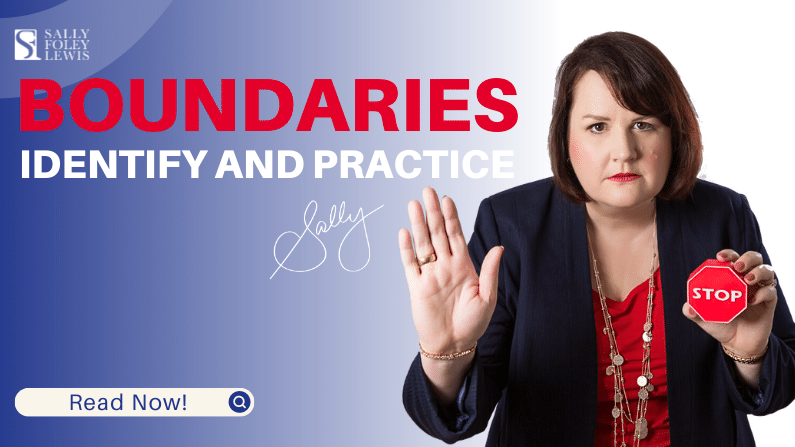How did your week of reflecting on boundaries go for you?
Last week, I share some strategies for you to consider when it comes to setting boundaries with your boss. This was a great question Concetta asked in the Content You Want survey.

I worked for a time at The Duke of Edinburgh’s Award program, and as a safety measure our CEO had a pager. This was the type of device where you would get a beep and then you’d have to call the number on the screen. Today, pagers are non-existent but even back then it was an old-fashioned version.
The reason for having a pager was because a component of the youth program involved young people going on outdoor expeditions. This would include hiking and camping and all manner of outdoor activities. The pager was so the CEO could be contacted in case of an emergency should any of the young people find themselves in any form of distress. In the event of an emergency the young people would contact the relevant emergency or civil services first, and the CEO would be contacted soon after to handle the more administrative (and political) tasks.
It wasn’t until I became the CEO of the program that I learned the chairman of the board, Alan, would page the CEO at approximately 6:30am most weekday mornings wanting to discuss issues, projects or opportunities. The first time I was paged you can image my fright when I thought there had been an emergency with some of our young people in the program. I rang the number listed on the pager only to be confused by Alan answering the call to say he wanted to chat about the latest minutes of the board meeting and the international news for the program.
My predecessor hadn’t informed me that Alan used the pager as an alarm-clock-cum-call-me prompter … regularly! I wondered if the previous CEO hadn’t seemed to mind. I pondered whether he had clear or any boundaries for the use of emergency equipment or he didn’t have a clear boundary for his work and personal time.
When I approached Alan about his use of the pager, he hadn’t been aware that the device was only for emergencies. While he was somewhat apologetic about the mis-use he still wanted to reach me on his terms and on his timeframe. I reminded him of my standard work hours and told him that while I would always respond to an emergency at any time of the day, operational matters would be handled in standard work hours.
Was this easy for me to say? Not entirely. It took me some time to script out what I wanted to say and how I wanted to say it so that it would be received in the best possible way. Was I nervous when I approached Alan to have this conversation? Absolutely! And was he accepting and happy with what I had to say? Not exactly.
Alan asked for my mobile number and I declined to provide it as this was still early mobile phone days and our devices were not a standard part of our work equipment. I informed him that even with an employer-provided mobile phone I would not respond to out-of-hours operational calls.
It took him a few days to, let’s diplomatically say, digest my setting of this boundary. But once he could see I was not going to budge he adjusted. When his term ended, he did mention to me privately that he realised he hadn’t considered the impact he had on the CEO role, though he did want the last word by saying that he was operating from a drive to get as much done as possible.
For me, this was an invaluable lesson in boundaries. If I let the behaviour continue as per my predecessor, then I know I would have struggled to maintain a positive relationship with Alan. I would have reached frustration very quickly and our working relationship would have suffered. As it was it only took a few days of awkwardness and then we got back into the day-to-day of our respective jobs, working well together.
If I had not taken the time to think about what and how to say what I needed to say, or if I had just blurted out my frustration, I would have really damaged the relationship, or even jeopardised my job. This process not only helped save an important working relationship, it also helped me be more self-aware and be more effective in leading myself.
While I was nervous, and while I couldn’t guarantee how he would respond or react to my boundary, it was a conversation that still had to happen. I had no idea if he would agree to my boundary setting, but I knew I was worthy of protecting my time and it was worth thinking of the long-term quality of our relationship.
The quality of my relationship with Alan had a very real connection with my employment status and in those kinds of cases it can be challenging to set and hold boundaries. It’s always more difficult with those who are more senior or whose good opinion you don’t want to lose.
American psychologist and author, Adam Grant sums it up well when he challenges us to keep in mind, ‘It’s impossible to please everyone. The question is whether you’re disappointing the right people. Part of setting healthy boundaries is deciding who you’re willing to let down—and who has the right to make you feel guilty. Not everyone deserves power over your emotions’.
Boundaries are not new. The phrase, ‘good fences make good neighbours’ is traced as far back as 1914. Even Benjamin Franklin, one of the founding fathers of the United States, is known to have said, ‘Love thy neighbour, yet don’t pull down your hedge’.
A boundary is quite simply a line that marks a limit!
However, in Frost’s poem, Mending Wall, which reiterates this phrase, it’s actually used to show how walls can keep people out of our lives with negative consequences. And it’s true that too tight or too rigid boundaries may lead to you missing out on opportunities. You could be keeping others at a distance who could be a help or support to you. You may be perceived as aloof or detached from others. And you may even have fewer relationships because others may not find it easy to build a relationship with you.
Conversely, boundaries that are too loose or too open may mean that you find yourself getting too close to other people’s problems or drama, oversharing your own personal information, struggling to say no to requests or even feeling drawn into seeking others approval, whether out of a desire to please or because you fear their rejection.
Boundaries can be personal, physical or psychological. But regardless of their type, when it comes to the boundaries you may have, they could impact many areas of your life such as:
- Personal or physical space
- Time
- Culture and/or religion
- Ethics
- Possessions
- Sexuality
- Emotions and thoughts
When you identify, set and hold a healthy boundary you will find that this helps conserve your emotional and physical energy. In the case of Alan and the pager, once I set and held the boundary, I felt as though my energy was no longer being zapped away or re-directed to an issue of frustration but could be directed to the work I needed to do at the time I needed to do it.
Benefits of Boundaries
Healthy boundaries can have many benefits. They will help boost your self-esteem and self-worth because you have put in place a measure that will protect your values and your needs. They will also give you the skills, experience and courage to respect your own and others’ boundaries. And it will give you more agency—more control and confidence over your actions and the consequences.
Practice: Identify a Boundary
Have you ever been in a situation where you felt completely zapped, drained or stressed or where you found that you’ve got a knot in your stomach or felt like crying?
Consider a situation where you’ve felt this?
Reflect on that situation, taking into consideration what was said, how things were said and how you responded versus how you may have wanted to respond. (For example, maybe you said yes when you would have preferred to say no.)
What caused your feelings of upset? Was it more the situation or the people? Or was it a meeting, event or project that caused or triggered the uncomfortable feeling?
This reflection should give you insight into the situations, words, actions or events where you would benefit from setting a healthy boundary so you can handle them better. Or, better yet, not have to deal with them at all. Even if the situation is unavoidable it can give you clarity on how the situation can be handled.
Identification is the first step. Setting boundaries is the next step.
Practice: Setting Boundaries
A simple strategy for setting boundaries is to finish the following sentences.
You may not …
Others may not …
People may not …
For example:
… hug me unless I say it’s okay.
… gossip to me about others when those people are not there to defend themselves.
… add meetings into the blocked off time in my calendar without asking me first.
It is okay for me to protect myself by …
For example:
… not replying to emails out of office hours.
… not answering phone calls out of office hours.
… closing the office door.
It’s okay for me to ask for…
I’m entitled to ask for…
I have the right to ask for…
For example:
…time off.
… help.
… clarification on an issue.
… privacy.
… feedback.
It’s okay if these are not perfect. See your statements as a first draft and not necessarily right or wrong. They are your boundaries and you can tweak them as you continue to spark your self-leadership and especially your self-awareness.
The more you work on these the clearer you’ll become about what your boundaries need to be. If I wasn’t clear with Alan, and if he didn’t understand exactly the boundaries I was setting, he would have continued to page me and continued to expect me to be available at unreasonable hours of the day. If I was unclear it would be akin to being unkind because it would have negatively affected our relationship. I may have inadvertently blown up at him and it would most certainly have been my fault, not his. He would simply have been operating according to what he believed was acceptable behaviour.
Let me know how you get on.




